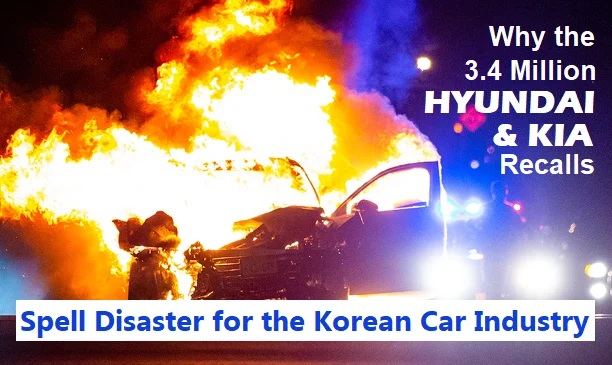The Hyundai and Kia recalls, involving over 3.4 million vehicles in 2024 due to fire risks from defective components, expose significant operational risk. The brands’ inability to detect flaws in the hydraulic electronic control unit (HECU), delayed responses, and ineffective communication highlight serious systemic operational failures at both these organizations that can potentially take down the entire car industry in Korea.
Why Hyundai and Kia together? Hyundai and Kia are technically separate brands, but they are closely related because Hyundai Motor Group owns a significant stake in Kia. The connection between the two companies dates back to the late 1990s, when Kia faced financial difficulties and was bought by Hyundai Motor Group in 1998. Since then, they have shared resources, technology, and even manufacturing platforms. Thus the same components are likely used in both brands and pose an equally serious risk to drivers, passengers and the public at large.
The Operational Failures
The most troubling aspect of Hyundai and Kia’s ongoing safety recalls is their inability to swiftly and effectively address these defects. The recurrence of fire risks in multiple models points to a failure in the companies’ safety and quality control processes. This has undermined customer trust, as these are not isolated incidents but recurring problems that span over a decade. Several key operational failures have emerged:
Ineffective Detection and Testing Mechanisms
The ability of Hyundai and Kia to detect potential hazards before vehicles hit the market has been called into question. Despite advanced technology, the fire risks stemming from the HECU short circuits persisted, indicating flaws in both design testing and component validation.
Delayed Response to Customer Complaints
One of the most critical failures has been the delayed response to customer complaints and regulatory investigations. While numerous fire incidents were reported in both the United States and other countries, the companies were slow to act, with recalls being issued only after severe regulatory pressure. This highlights an inadequacy in monitoring post-market data and responding promptly to safety concerns.
Inconsistent Communication and Vehicle Safety Advice
Another operational control that faltered was communication with customers. Many vehicle owners were unaware of the fire risks until recalls were announced, and in some cases, the advice given by the automakers (such as parking cars outside to avoid potential fires) was seen as inadequate. This breakdown in transparent communication has heightened concerns about Hyundai and Kia’s customer engagement strategies during crises.
Failure to Address Root Causes
Hyundai and Kia’s inability to permanently address the root cause of these safety issues points to deeper flaws in engineering and production processes. The recurrence of defects, despite multiple recalls over the years, reflects that they have not been able to implement lasting solutions to prevent similar hazards in the future.
The Internal Controls that Failed
Design and Manufacturing Oversight. There seems to be a lack of robust checks during the design and production phases. The recurring fire risks related to the HECU highlight an oversight in component testing, suggesting that critical quality checks were either skipped or insufficient.
Supply Chain Management. The sourcing of faulty components points to possible gaps in supply chain management. Hyundai and Kia may not have exerted enough control over their suppliers or failed to enforce stringent quality standards on parts crucial to vehicle safety.
Regulatory Compliance and Safety Audits. Internal auditing mechanisms also appear to have failed. A more rigorous internal review of safety standards could have identified the flaws earlier. Additionally, the delayed response to regulatory pressure suggests that compliance controls, designed to ensure adherence to safety regulations, were either inadequate or not properly enforced.
Lessons Learnt
The shared technology between Hyundai and Kia amplifies the risks, as any defect in their common systems can propagate across both brands, affecting a large number of vehicles and putting more drivers at risk. This interconnectedness means that a flaw in a single component, such as the hydraulic electronic control unit (HECU), could trigger widespread recalls and safety concerns, impacting the reputation and financial stability of both companies simultaneously.
To prevent such risks, Hyundai and Kia could have implemented several key strategies:
- Independent Quality Control for Shared Technologies: While sharing technology offers cost efficiencies, it also requires more stringent checks. Hyundai and Kia should have instituted independent quality control audits specific to shared components, ensuring that any potential flaws are caught early before mass production.
- Robust Component Testing and Validation: More rigorous testing of critical components, especially those used across both brands, could have identified the fire risks linked to the HECU. Incorporating real-world testing conditions into the design and validation stages would have provided a more accurate understanding of potential safety issues before vehicles were released to the market.
- Enhanced Collaboration with Suppliers: The companies should have enforced stricter quality control measures with their suppliers, especially for safety-critical parts. Regular audits, coupled with higher standards for supplier accountability, would ensure that faulty or subpar components do not make it into production.
- Stronger Post-Market Surveillance Systems: A centralized, real-time monitoring system for tracking customer complaints, vehicle performance, and safety reports across both brands would have enabled Hyundai and Kia to detect emerging issues faster. This proactive approach could have led to quicker recalls and prevented widespread problems.
- Segmentation of Technology for Risk Mitigation: While shared platforms and technology are cost-effective, segmenting certain high-risk components and technologies between the two brands could have minimized the impact of any one failure. This strategic separation would have contained the risks to a single brand instead of both.
Had these measures been in place, Hyundai and Kia might have mitigated the widespread impact of their operational failures, preventing the systemic risk that now threatens both their brands and the broader car industry.

